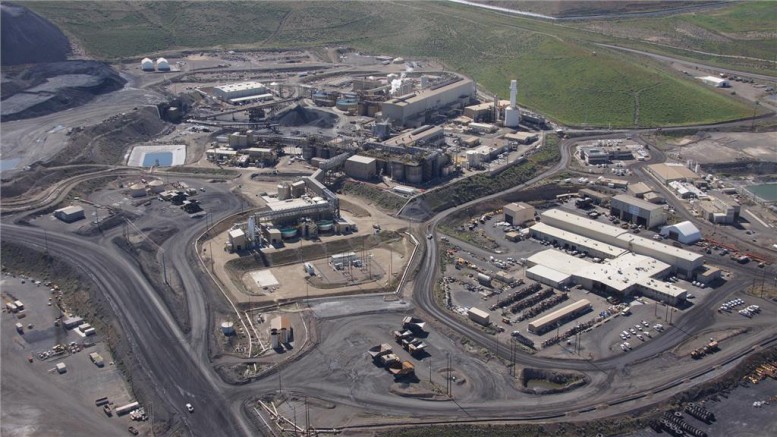Barrick Gold (TSX: ABX; NYSE: ABX) hit a major milestone late last year, after it poured its first cyanide-free gold bar at its Goldstrike operations in Nevada using nothing other than a common potato fertilizer.
The reagent, known as thiosulphate, is a sulphur-oxide, non-toxic compound that helps liberate gold from ores that would otherwise be unrecoverable with traditional methods such as cyanide leaching.
“Gold is often locked into minerals, or trapped by too much sulphur or carbon and sometimes you just can’t recover enough of it to be profitable,” Peter Kondos, senior manager of research and development tells Mining Trends & Developments from his office in Toronto. “There’s significant interest for us, and for our colleagues out there, to find a new technology that’ll overcome those challenges and turn those economics around.”
For the past two decades, Kondos says Barrick had “the guts and stamina” to investigate and pioneer the avant-garde technique, alongside other international miners such as Newmont Mining (NYSE: NEM) and Placer Dome, who were also exploring its potential.
Barrick acquired all the thiosulphate patents and know-how from Placer Dome with the acquisition of the company in 2006. Since then, Barrick has become a leader in the field, using Goldstrike’s cyanide resistant ore as the world’s first test hub.
“Nothing beats a good cyanide system, it’s so efficient and well understood, but it doesn’t work at Goldstrike,” he says. “Our alternative was to turn off the autoclaves, because we had no other material that it could handle. Thiosulphate was our only choice.”
Stockpiled at the company’s mine site is 4 million tonnes of “double-refractory” ore, a term used to describe a rock containing both sulphides and carbonaceous matter along with the precious metal.
During conventional processing, the sulphides that bind the gold can be broken down, or oxidized, by either pressure leaching through an autoclave, or burned in high-temperature reactors.
Once the gold is liberated from the mineral structures, cyanide is flushed through the system and grabs onto the gold floating about in the slurry. But if there’s any carbon present, the organics will steal the yellow metal out of solution first.
Recoveries in double refractory ores can be as low as 10 to 15%, Kondos says, but thiosulphate works against the carbon and can bump recoveries up to 80% or higher.
“Compared to cyanide, you require more thiosulphate because it’s a weaker complexing agent, and it can be oxidized or lost in other chemical reactions,” he says.
“But it’s relatively much cheaper to buy, and we take great care of recycling all the solutions inside so none of the thiosulphate is lost or goes to waste.”
After an investment of US$620 million, which included upgrades to the leaching circuits at Goldstrike, a thiosulphate manufacturing plant to supply the chemical, and a new water treatment plant that will allow the company to recycle large amounts of thiosulphate, the new plant is expected to contribute an annual average of 350,000 to 450,000 oz. gold. That’s almost half of the 1 to 1.15 million oz. gold Barrick expects to produce this year at the operation.
All-in sustaining costs are projected to fall between US$700 to US$800 per oz. gold.
“We’ve been having no problems on any technical issues, the plant has been performing very well,” he says.
Kondos adds that in 2010, Barrick had a demonstration plant running at Goldstrike for 16 months just to “run the process through the rails to see if it worked,” and established a peer review committee of experts and groups from around the world to solve any road blocks.
One such group is the Australian think tank Commonwealth Scientific and Industrial Research Organization (CSIRO), who Kondos says has been instrumental in driving the industrial process in recent years.
“The amount of time, investment and collaboration that went into this is something we’re really proud of,” he says. “At Barrick, we now have a good understanding of where it works, where it doesn’t and what the economics are.”
Although the company has patented the technology, Kondos says it’s available to anyone else in the industry to use for a nominal royalty and free for research projects.
“We’re open to anyone who wants to develop it further and use it as a baseline for something else,” he says, emphasizing that it often takes a consortium of people to overcome technical challenges.
He says there’s an effort to try and adapt this new technology to work well with a variety of ores and deposit styles, but “it’s not an easy system and there’s still a lot more work that needs to be done.”
— This article originally appeared in the November 2015 issue of Mining Trends & Developments.


Be the first to comment on "Barrick pioneers cyanide-free processing at Goldstrike"